-
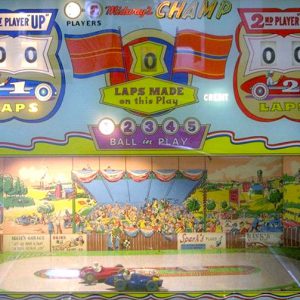
-
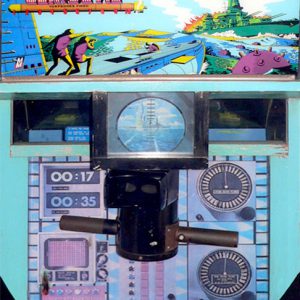 This was one of my favorite arcade machines in its heyday. Midway found much success with this one-player machine. A faux periscope is the viewing platform for action in this battle to sink enemy ships. You are allowed a fixed number of torpedoes per game to sink as much tonnage as possible per outing. A perfect game awards bonus torpedoes. The lighting effects and sounds are wonderful for their day. You’re allowed to “steer” your torpedo to about one-fourth of theway to your enemy. Giving just the right amount of lead time to each ship is critical. Some shipsare faster than others and these sinkings award more points. Go ahead, captain, sink the fleet!
This was one of my favorite arcade machines in its heyday. Midway found much success with this one-player machine. A faux periscope is the viewing platform for action in this battle to sink enemy ships. You are allowed a fixed number of torpedoes per game to sink as much tonnage as possible per outing. A perfect game awards bonus torpedoes. The lighting effects and sounds are wonderful for their day. You’re allowed to “steer” your torpedo to about one-fourth of theway to your enemy. Giving just the right amount of lead time to each ship is critical. Some shipsare faster than others and these sinkings award more points. Go ahead, captain, sink the fleet! -
 Sharp Shooter is an EM Rifle game. The shooter can choose from a variety of targets in a well-decorated range, which uses black lights to make some interesting pictures. The shooter can choose from candles, tumbling acrobats, bicycle-riding clowns, ducks and a bonus bullseye. The candles are worth 200 points; the bonus target switches from 100-200-300 points; and the other targets vary shot by shot from 30-50-100 points. The game has provisions for setting the replay score, number of shots per game and a random-miss factor and a recoil solenoid. The game also has electronic sounds such as ducks quacking.
Sharp Shooter is an EM Rifle game. The shooter can choose from a variety of targets in a well-decorated range, which uses black lights to make some interesting pictures. The shooter can choose from candles, tumbling acrobats, bicycle-riding clowns, ducks and a bonus bullseye. The candles are worth 200 points; the bonus target switches from 100-200-300 points; and the other targets vary shot by shot from 30-50-100 points. The game has provisions for setting the replay score, number of shots per game and a random-miss factor and a recoil solenoid. The game also has electronic sounds such as ducks quacking. -
 Atari PONG was released in June 1972 and is the first commercially successful video game and is based on a simple two-dimensional graphical representation of a tennis-like game. Players use paddles to hit a ball back and forth on a black and white screen. Pong was the first game developed by Atari Inc., by Nolan Bushnell and Ted Dabney. Pong (marketed as PONG) is one of the earliest arcade video games, and is a tennis sports game featuring simple two-dimensional graphics. The player controls an in-game paddle by moving it vertically across the left side of the screen, and can compete against either a computer controlled opponent or another player controlling a second paddle on the opposing side. Players use the paddles to hit a ball back and forth. The aim is for a player to earn more points than the opponent; points are earned when one fails to return the ball to the other. Pong consistently earned four times more revenue than other coin-operated machines, which resulted in an increase in the number of orders Atari received. This provided Atari with a steady source of income; the company sold the machines at three times the cost of production. By 1973, the company had filled 2,500 orders, and, at the end of 1974, sold more than 8,000 units.[20] The arcade cabinets have since become collector’s items with the cocktail-table version being the rarest. Atari eventually sold more than 35,000 units, however, many more imitations were produced by competitors.
Atari PONG was released in June 1972 and is the first commercially successful video game and is based on a simple two-dimensional graphical representation of a tennis-like game. Players use paddles to hit a ball back and forth on a black and white screen. Pong was the first game developed by Atari Inc., by Nolan Bushnell and Ted Dabney. Pong (marketed as PONG) is one of the earliest arcade video games, and is a tennis sports game featuring simple two-dimensional graphics. The player controls an in-game paddle by moving it vertically across the left side of the screen, and can compete against either a computer controlled opponent or another player controlling a second paddle on the opposing side. Players use the paddles to hit a ball back and forth. The aim is for a player to earn more points than the opponent; points are earned when one fails to return the ball to the other. Pong consistently earned four times more revenue than other coin-operated machines, which resulted in an increase in the number of orders Atari received. This provided Atari with a steady source of income; the company sold the machines at three times the cost of production. By 1973, the company had filled 2,500 orders, and, at the end of 1974, sold more than 8,000 units.[20] The arcade cabinets have since become collector’s items with the cocktail-table version being the rarest. Atari eventually sold more than 35,000 units, however, many more imitations were produced by competitors. -
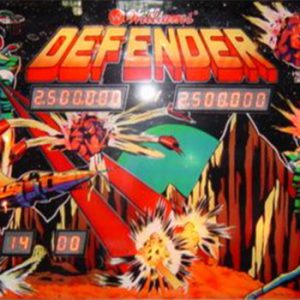 Defender is an arcade video game developed and released by Williams Electronics in 1980. A shooting game featuring two-dimensional (2D) graphics, the game is set on a fictional planet where the player must defeat waves of invading aliens while protecting astronauts. Development was led by Eugene Jarvis, a pinball programmer at Williams; Defender was Jarvis’ first video game project, and drew inspiration from Space Invaders and Asteroids. Defender is a two-dimensional side-scrolling shooting game set on the surface of an unnamed planet. The player controls a space ship as it navigates the terrain, flying either to the left or right. A joystick controls the ship’s elevation, and five buttons control its horizontal direction and weapons. The object is to destroy alien invaders, while protecting astronauts on the landscape from abduction. Humans that are successfully abducted return as mutants that attack the ship. Defeating the aliens allows the player to progress to the next level. Failing to protect the astronauts, however, causes the planet to explode and the level to become populated with mutants. Surviving the waves of mutants results in the restoration of the planet. Players are allotted three chances (lives) to progress through the game and are able to earn more by reaching certain scoring benchmarks. A life is lost if the ship comes into contact with an enemy or its projectiles. After exhausting all lives, the game ends. Defender is an arcade video game developed and released by Williams Electronics in 1980. A shooting game featuring two-dimensional (2D) graphics, the game is set on a fictional planet where the player must defeat waves of invading aliens while protecting astronauts. Development was led by Eugene Jarvis, a pinball programmer at Williams; Defender was Jarvis’ first video game project and drew inspiration from Space Invaders and Asteroids. Defender was one of the most important titles of the Golden Age of Arcade Games, selling over 55,000 units to become the company’s best selling game and one of the highest-grossing arcade games ever. Praise among critics focused on the game’s audio-visuals and gameplay. It is frequently listed as one of Jarvis’ best contributions to the video game industry as well as one of the most difficult video games. Defender was ported to numerous platforms, inspired the development of other games, and was followed by sequels and many imitations. Defender is a two-dimensional side-scrolling shooting game set on the surface of an unnamed planet. The player controls a space ship as it navigates the terrain, flying either to the left or right. A joystick controls the ship’s elevation, and five buttons control its horizontal direction and weapons. The object is to destroy alien invaders while protecting astronauts on the landscape from abduction. Humans who are successfully abducted return as mutants that attack the ship. Defeating the aliens allows the player to progress to the next level. Failing to protect the astronauts, however, causes the planet to explode and the level to become populated with mutants. Surviving the waves of mutants results in the restoration of the planet. Players are allotted three chances (lives) to progress through the game and are able to earn more by reaching certain scoring benchmarks. A life is lost if the ship comes into contact with an enemy or its projectiles. After exhausting all lives, the game end.
Defender is an arcade video game developed and released by Williams Electronics in 1980. A shooting game featuring two-dimensional (2D) graphics, the game is set on a fictional planet where the player must defeat waves of invading aliens while protecting astronauts. Development was led by Eugene Jarvis, a pinball programmer at Williams; Defender was Jarvis’ first video game project, and drew inspiration from Space Invaders and Asteroids. Defender is a two-dimensional side-scrolling shooting game set on the surface of an unnamed planet. The player controls a space ship as it navigates the terrain, flying either to the left or right. A joystick controls the ship’s elevation, and five buttons control its horizontal direction and weapons. The object is to destroy alien invaders, while protecting astronauts on the landscape from abduction. Humans that are successfully abducted return as mutants that attack the ship. Defeating the aliens allows the player to progress to the next level. Failing to protect the astronauts, however, causes the planet to explode and the level to become populated with mutants. Surviving the waves of mutants results in the restoration of the planet. Players are allotted three chances (lives) to progress through the game and are able to earn more by reaching certain scoring benchmarks. A life is lost if the ship comes into contact with an enemy or its projectiles. After exhausting all lives, the game ends. Defender is an arcade video game developed and released by Williams Electronics in 1980. A shooting game featuring two-dimensional (2D) graphics, the game is set on a fictional planet where the player must defeat waves of invading aliens while protecting astronauts. Development was led by Eugene Jarvis, a pinball programmer at Williams; Defender was Jarvis’ first video game project and drew inspiration from Space Invaders and Asteroids. Defender was one of the most important titles of the Golden Age of Arcade Games, selling over 55,000 units to become the company’s best selling game and one of the highest-grossing arcade games ever. Praise among critics focused on the game’s audio-visuals and gameplay. It is frequently listed as one of Jarvis’ best contributions to the video game industry as well as one of the most difficult video games. Defender was ported to numerous platforms, inspired the development of other games, and was followed by sequels and many imitations. Defender is a two-dimensional side-scrolling shooting game set on the surface of an unnamed planet. The player controls a space ship as it navigates the terrain, flying either to the left or right. A joystick controls the ship’s elevation, and five buttons control its horizontal direction and weapons. The object is to destroy alien invaders while protecting astronauts on the landscape from abduction. Humans who are successfully abducted return as mutants that attack the ship. Defeating the aliens allows the player to progress to the next level. Failing to protect the astronauts, however, causes the planet to explode and the level to become populated with mutants. Surviving the waves of mutants results in the restoration of the planet. Players are allotted three chances (lives) to progress through the game and are able to earn more by reaching certain scoring benchmarks. A life is lost if the ship comes into contact with an enemy or its projectiles. After exhausting all lives, the game end. -
 Galaxian (Gyarakushian?) is an arcade game that was developed by Namco and released in October 1979. It was published by Namco in Japan and imported to North America by Midway that December. A fixed shooter game in which the player controls a spaceship at the bottom of the screen, and shoots enemies descending in various directions, it was designed to compete with Taito Corporation’s successful earlier game Space Invaders (which was released in the previous year, and also imported to the US by Midway Games). The game was highly popular for Namco upon its release, and has been a focus of competitive gaming ever since. It spawned a successful sequel, Galaga, in 1981, and the lesser known Gaplus and Galaga ‘88 in 1984 and 1987 respectively, as well as many later ports and adaptations. Along with its immediate sequel, it was one of the most popular games during the golden age of arcade video games. Galaxian expanded on the formula pioneered by Space Invaders. As in the earlier game, Galaxian features a horde of attacking aliens that exchanged shots with the player. In contrast to Space Invaders, Galaxian added an element of drama by having the aliens periodically make kamikaze-like dives at the player’s ship, the Galaxip.[1] This made it the first game to feature enemies with individual personalities.[2] The game’s plot consists of a title screen that displayed the message “WE ARE THE GALAXIANS / MISSION: DESTROY ALIENS”.[3] Galaxian was very successful for Namco and introduced several “firsts”. Although not the first color video game, Galaxian took RGB color graphics a step further with multi-colored animated sprites and explosions, different colored fonts for the score and high score, the scrolling starfield, and graphic icons that show the number of lives left and how many stages the player had completed. It also features a crude theme song and more prominent background “music.” These elements combine to create a look and feel that would set the standard for arcade games in the 1980s such as Pac-Man. Gameplay The gameplay is relatively simple. Swarm after swarm of alien armies attack the player’s ship that moves left and right at the bottom of the wraparound screen. The ship can only have one shot on screen at a time. The player defeats one swarm, only to have it replaced by another more aggressive and challenging swarm in the next stage. A plain and repetitive starfield scrolls in the background.
Galaxian (Gyarakushian?) is an arcade game that was developed by Namco and released in October 1979. It was published by Namco in Japan and imported to North America by Midway that December. A fixed shooter game in which the player controls a spaceship at the bottom of the screen, and shoots enemies descending in various directions, it was designed to compete with Taito Corporation’s successful earlier game Space Invaders (which was released in the previous year, and also imported to the US by Midway Games). The game was highly popular for Namco upon its release, and has been a focus of competitive gaming ever since. It spawned a successful sequel, Galaga, in 1981, and the lesser known Gaplus and Galaga ‘88 in 1984 and 1987 respectively, as well as many later ports and adaptations. Along with its immediate sequel, it was one of the most popular games during the golden age of arcade video games. Galaxian expanded on the formula pioneered by Space Invaders. As in the earlier game, Galaxian features a horde of attacking aliens that exchanged shots with the player. In contrast to Space Invaders, Galaxian added an element of drama by having the aliens periodically make kamikaze-like dives at the player’s ship, the Galaxip.[1] This made it the first game to feature enemies with individual personalities.[2] The game’s plot consists of a title screen that displayed the message “WE ARE THE GALAXIANS / MISSION: DESTROY ALIENS”.[3] Galaxian was very successful for Namco and introduced several “firsts”. Although not the first color video game, Galaxian took RGB color graphics a step further with multi-colored animated sprites and explosions, different colored fonts for the score and high score, the scrolling starfield, and graphic icons that show the number of lives left and how many stages the player had completed. It also features a crude theme song and more prominent background “music.” These elements combine to create a look and feel that would set the standard for arcade games in the 1980s such as Pac-Man. Gameplay The gameplay is relatively simple. Swarm after swarm of alien armies attack the player’s ship that moves left and right at the bottom of the wraparound screen. The ship can only have one shot on screen at a time. The player defeats one swarm, only to have it replaced by another more aggressive and challenging swarm in the next stage. A plain and repetitive starfield scrolls in the background. -
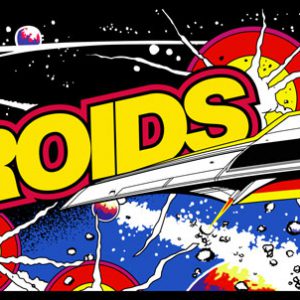 Yet another legendary, genre-defining game – in an era replete with genre-defining classics - in which a single player takes control of a ship trapped in the middle of an asteroid field. A number of large, slow-moving asteroids drift randomly around the play area and must be shot by the player. When shot, the asteroids will break into a number of smaller pieces, which must also be shot until, eventually, all of the asteroids and fragments will be destroyed and the next wave begins. Asteroids introduced real-world physics to video games for the first time, with speed and inertia all adding to the player’s problems. As well as the inertia of the player’s ship – forcing the player to allow for the ship slowing down and speeding up whenever the thrust button was utilized – shot asteroids would often send fragments flying in seemingly random directions, and at varying and unpredictable speeds. As well as the ever-present asteroids, alien saucers also make a regular appearance. These move diagonally around the screen, firing at the player’s ship and must be quickly destroyed.
Yet another legendary, genre-defining game – in an era replete with genre-defining classics - in which a single player takes control of a ship trapped in the middle of an asteroid field. A number of large, slow-moving asteroids drift randomly around the play area and must be shot by the player. When shot, the asteroids will break into a number of smaller pieces, which must also be shot until, eventually, all of the asteroids and fragments will be destroyed and the next wave begins. Asteroids introduced real-world physics to video games for the first time, with speed and inertia all adding to the player’s problems. As well as the inertia of the player’s ship – forcing the player to allow for the ship slowing down and speeding up whenever the thrust button was utilized – shot asteroids would often send fragments flying in seemingly random directions, and at varying and unpredictable speeds. As well as the ever-present asteroids, alien saucers also make a regular appearance. These move diagonally around the screen, firing at the player’s ship and must be quickly destroyed. -
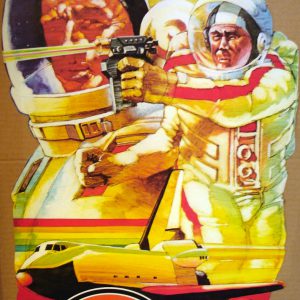 Move a paddle back and forth at the bottom of the screen to rebound a ball back into a brick wall, knocking bricks out one by one. There are three separate games: double — same as Breakout, knock down bricks and when they are all gone a new wall forms cavity — two other balls are inside the wall, when they have an escape route you can hit them as well progressive — as the wall is destroyed, new bricks are added and the entire wall shifts down toward your paddle. The sound effects are just simple beeps. This video game is a typical late ’70s machine which has been reproduced in many variations as well as downloaded apps on smartphones today. No complicated rules here, which is why it was so popular in its glory days. You control the horizontal paddle at the bottom of the playfield and, through the use of the spin controller, try to prevent losing the “ball” below the paddle. By aiming at the bricks, you try to hit all of them and then “break through” to the next layer of bricks. This accomplishment is rewarded with a period of high scoring and ricocheting video bounces of the “ball” until it escapes the brick layer and comes into your paddle again. These brick layers then start to drop toward your paddle. By the way, the TV is black and white!
Move a paddle back and forth at the bottom of the screen to rebound a ball back into a brick wall, knocking bricks out one by one. There are three separate games: double — same as Breakout, knock down bricks and when they are all gone a new wall forms cavity — two other balls are inside the wall, when they have an escape route you can hit them as well progressive — as the wall is destroyed, new bricks are added and the entire wall shifts down toward your paddle. The sound effects are just simple beeps. This video game is a typical late ’70s machine which has been reproduced in many variations as well as downloaded apps on smartphones today. No complicated rules here, which is why it was so popular in its glory days. You control the horizontal paddle at the bottom of the playfield and, through the use of the spin controller, try to prevent losing the “ball” below the paddle. By aiming at the bricks, you try to hit all of them and then “break through” to the next layer of bricks. This accomplishment is rewarded with a period of high scoring and ricocheting video bounces of the “ball” until it escapes the brick layer and comes into your paddle again. These brick layers then start to drop toward your paddle. By the way, the TV is black and white! -
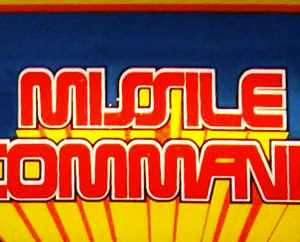 Missile Command is a 1980 arcade game by Atari, Inc. that was also licensed to Sega for European release. It is considered one of the most notable games from the Golden Age of Video Arcade Games. The plot of Missile Command is simple: the player’s six cities are being attacked by an endless hail of ballistic missiles, some of them even splitting like multiple independently targetable reentry vehicles (MIRVs), and in later levels smart bombs which can evade a less than perfectly targeted missile. As a regional commander of three anti-missile batteries, the player must defend six cities in their zone from being destroyed. The game is played by moving a crosshair across the sky background via a trackball and pressing one of three buttons to launch a counter-missile from the appropriate battery. Counter-missiles explode upon reaching the crosshair, leaving a fireball that persists for several seconds and destroys any enemy missiles that enter it. There are three batteries, each with ten missiles; a missile battery becomes useless when all its missiles are fired, or if the battery is destroyed by enemy fire. The missiles of the central battery fly to their targets at much greater speed; only these missiles can effectively kill a smart bomb at a distance. The game is staged as a series of levels of increasing difficulty; each level contains a set number of incoming enemy weapons. The weapons attack the six cities, as well as the missile batteries; being struck by an enemy weapon results in destruction of the city or missile battery. Enemy weapons are only able to destroy 3 cities during one level. A level ends if all the cities are destroyed, or when all enemy weaponry is destroyed or reaches its target. A player who runs out of missiles no longer has control over the remainder of the level. At the conclusion of a level, the player receives bonus points for any remaining cities or unused missiles. Between levels missile batteries are rebuilt and replenished; destroyed cities are rebuilt only at set point levels (usually 10 or 12K). The game inevitably ends when all six cities have been wiped out. Like most early arcade games, there is no way to “win” the game; the game just keeps going with ever faster and more prolific incoming missiles. The game, then, is just a contest in seeing how long the player can survive. On conclusion of the game, the screen displays “The End”, perhaps a poke at oncoming Nuclear Holocaust rather than the standard “Game Over” text (however, if the player is able to make the high score list, the game then prompts the player to enter his/her initials, with the “The End” sequence skipped). The game features an interesting bug: once a score of 810,000 is reached, a large number of cities are awarded (176 cities plus the continuing accrual of bonus cities) and it is possible to carry on playing for several hours. At some later stage the speed of missiles increases greatly for a few screens. On the 255th and 256th yellow screens, known as the 0x stages, the scoring increases by 256 times the base value. For good players these two 0x stages could earn over a million points. This enabled them to reach a score of approximately 2,800,000 (although only 6 digit scores were shown, so it would display 800,000) and at this point the accelerated rate would suddenly cease and the game would restart at its original (slow) speed and return to the first stage, but with the score and any saved cities retained. In this way it was possible to play this game for hours on end. Targeting crosshair: Aim your missiles quickly but carefully. Use the trackball to move the targeting crosshair to where you want the next missile to go, then press any Launch Control button to fire the missile. The missile will explode where the crosshair was positioned when the Launch Control button was pressed. Cities: There are six cities in total on the screen at one time, three on either side of the Delta Base. If one enemy missile or Smart Bomb manages to strike a city, that city will be wiped out. When all cities are destroyed, the game is over. Alpha Base: The missile base on the left side of the screen. Press the leftmost Launch Control button to launch an ABM from the Alpha Base. Delta Base: The missile base in the center of the screen. Press the middle Launch Control button to launch an ABM from the Delta Base. Omega Base: The missile base on the right side of the screen. Press the rightmost Launch Control button to launch an ABM from the Omega Base. NOTE: The Alpha and Omega Bases launch ABMs at a slower speed than the Delta Base, so you must plan further ahead when launching missiles from those bases. Defensive Missiles : The ABMs you launch to protect your cities. Each missile base contains 10 ABMs per wave. If any missile base is struck by an attack missile or smart bomb, the remaining stock of missiles for that wave are destroyed, and the missile base is rendered useless until the next wave. You receive bonus points for every ABM you have remaining at the end of each wave. Attack Missiles : Their only aim is to destroy your cities and missile bases. Every missile wave starts off with a hailstorm of attack missiles. They never deviate from their path. They may, however, turn into MIRVs. MIRV : Surprise! There is no warning when an attack missile turns into an MIRV (with multiple warheads). Think fast. Each new missile that the MIRV unleashes is carefully targeted. Killer Satellite: A mean-looking satellite that travels across the sky at a mid-level altitude and fires attack missiles. First appears in Wave 2. Bomber: A big slow-moving target that flies across the sky at a mid-level altitude, but watch out! It fires attack missiles. First appears in Wave 2. WARNING: If you destory a bomber or killer satellite before they deploy their missiles, you may see their missiles added to the downpour. An existing missile may also turn into an MIRV. Smart Bomb: Smart enough to avoid most explosion clouds from your ABMs. Your ABM must explode next to one in order to destroy it. You can also squeen it between two explosions to destroy it. First appears in Wave 5. ‘LOW’ Warning: As soon as there are only three ABMs left in a missile base, the game displays the word “LOW” underneath that base, and a warning signal sounds. Heed the warning.
Missile Command is a 1980 arcade game by Atari, Inc. that was also licensed to Sega for European release. It is considered one of the most notable games from the Golden Age of Video Arcade Games. The plot of Missile Command is simple: the player’s six cities are being attacked by an endless hail of ballistic missiles, some of them even splitting like multiple independently targetable reentry vehicles (MIRVs), and in later levels smart bombs which can evade a less than perfectly targeted missile. As a regional commander of three anti-missile batteries, the player must defend six cities in their zone from being destroyed. The game is played by moving a crosshair across the sky background via a trackball and pressing one of three buttons to launch a counter-missile from the appropriate battery. Counter-missiles explode upon reaching the crosshair, leaving a fireball that persists for several seconds and destroys any enemy missiles that enter it. There are three batteries, each with ten missiles; a missile battery becomes useless when all its missiles are fired, or if the battery is destroyed by enemy fire. The missiles of the central battery fly to their targets at much greater speed; only these missiles can effectively kill a smart bomb at a distance. The game is staged as a series of levels of increasing difficulty; each level contains a set number of incoming enemy weapons. The weapons attack the six cities, as well as the missile batteries; being struck by an enemy weapon results in destruction of the city or missile battery. Enemy weapons are only able to destroy 3 cities during one level. A level ends if all the cities are destroyed, or when all enemy weaponry is destroyed or reaches its target. A player who runs out of missiles no longer has control over the remainder of the level. At the conclusion of a level, the player receives bonus points for any remaining cities or unused missiles. Between levels missile batteries are rebuilt and replenished; destroyed cities are rebuilt only at set point levels (usually 10 or 12K). The game inevitably ends when all six cities have been wiped out. Like most early arcade games, there is no way to “win” the game; the game just keeps going with ever faster and more prolific incoming missiles. The game, then, is just a contest in seeing how long the player can survive. On conclusion of the game, the screen displays “The End”, perhaps a poke at oncoming Nuclear Holocaust rather than the standard “Game Over” text (however, if the player is able to make the high score list, the game then prompts the player to enter his/her initials, with the “The End” sequence skipped). The game features an interesting bug: once a score of 810,000 is reached, a large number of cities are awarded (176 cities plus the continuing accrual of bonus cities) and it is possible to carry on playing for several hours. At some later stage the speed of missiles increases greatly for a few screens. On the 255th and 256th yellow screens, known as the 0x stages, the scoring increases by 256 times the base value. For good players these two 0x stages could earn over a million points. This enabled them to reach a score of approximately 2,800,000 (although only 6 digit scores were shown, so it would display 800,000) and at this point the accelerated rate would suddenly cease and the game would restart at its original (slow) speed and return to the first stage, but with the score and any saved cities retained. In this way it was possible to play this game for hours on end. Targeting crosshair: Aim your missiles quickly but carefully. Use the trackball to move the targeting crosshair to where you want the next missile to go, then press any Launch Control button to fire the missile. The missile will explode where the crosshair was positioned when the Launch Control button was pressed. Cities: There are six cities in total on the screen at one time, three on either side of the Delta Base. If one enemy missile or Smart Bomb manages to strike a city, that city will be wiped out. When all cities are destroyed, the game is over. Alpha Base: The missile base on the left side of the screen. Press the leftmost Launch Control button to launch an ABM from the Alpha Base. Delta Base: The missile base in the center of the screen. Press the middle Launch Control button to launch an ABM from the Delta Base. Omega Base: The missile base on the right side of the screen. Press the rightmost Launch Control button to launch an ABM from the Omega Base. NOTE: The Alpha and Omega Bases launch ABMs at a slower speed than the Delta Base, so you must plan further ahead when launching missiles from those bases. Defensive Missiles : The ABMs you launch to protect your cities. Each missile base contains 10 ABMs per wave. If any missile base is struck by an attack missile or smart bomb, the remaining stock of missiles for that wave are destroyed, and the missile base is rendered useless until the next wave. You receive bonus points for every ABM you have remaining at the end of each wave. Attack Missiles : Their only aim is to destroy your cities and missile bases. Every missile wave starts off with a hailstorm of attack missiles. They never deviate from their path. They may, however, turn into MIRVs. MIRV : Surprise! There is no warning when an attack missile turns into an MIRV (with multiple warheads). Think fast. Each new missile that the MIRV unleashes is carefully targeted. Killer Satellite: A mean-looking satellite that travels across the sky at a mid-level altitude and fires attack missiles. First appears in Wave 2. Bomber: A big slow-moving target that flies across the sky at a mid-level altitude, but watch out! It fires attack missiles. First appears in Wave 2. WARNING: If you destory a bomber or killer satellite before they deploy their missiles, you may see their missiles added to the downpour. An existing missile may also turn into an MIRV. Smart Bomb: Smart enough to avoid most explosion clouds from your ABMs. Your ABM must explode next to one in order to destroy it. You can also squeen it between two explosions to destroy it. First appears in Wave 5. ‘LOW’ Warning: As soon as there are only three ABMs left in a missile base, the game displays the word “LOW” underneath that base, and a warning signal sounds. Heed the warning. -
 It’s probably a very rare person who has never played Pac-Man. Even for those who may have missed it in the 1980s, Pac-Man has been re-made on nearly every video game platform since then. Pac-Man even appeared on the front page of Google (as a playable game) on Pac-Man’s 30th anniversary. However, for those few who are unfamiliar with the game, here are the basics. You, the player, control the yellow, circular Pac-Man using either keyboard arrows or a joystick. The goal is to move Pac-Man around the maze-like screen gobbling up all 240 dots before the four ghosts (sometimes called monsters) get you. The four ghosts are all different colors: Blinky (red), Inky (light blue), Pinky (pink), and Clyde (orange). However, they all turn dark blue when Pac-Man eats one of the four power pellets available on each level; the pellets enable Pac-Man to eat the ghosts. Occasionally, fruit will appear on the screen. If Pac-Man gobbles those up then he earns a point bonus, with different fruit worth different values. While all this is happening, Pac-Man makes a wocka-wocka sound that is nearly as memorable as the yellow character himself. When first launched in Japan by Namco in 1980, the game received a lukewarm response, as Space Invaders and other similar games were more popular at the time. However, the game found far more success in North America. Pac-Man’s success in North America took competitors and distributors completely by surprise in 1980. Marketing executives who saw Pac-Man at a trade show prior to release completely overlooked the game (along with the now-classic Defender), while they looked to a racing car game called Rally-X as the game to outdo that year. The appeal of Pac-Man was such that the game caught on immediately with the public; it quickly became far more popular than anything seen in the game industry up to that point. Pac-Man outstripped Asteroids as the best-selling arcade game in North America, grossing over $1 billion in quarters within a decade, by the end of the 1980s, surpassing the revenues grossed by the highest-grossing film “Star Wars”. The player controls Pac-Man through a maze, eating pac-dots (also called pellets). When all pac-dots are eaten, Pac-Man is taken to the next stage. Between some stages one of three intermission animations plays. Four enemies (Blinky, Pinky, Inky and Clyde) roam the maze, trying to catch Pac-Man. If an enemy touches Pac-Man, a life is lost and the Pac-Man itself withers and dies. When all lives have been lost, the game ends. Pac-Man is awarded a single bonus life at 10,000 points by default.
It’s probably a very rare person who has never played Pac-Man. Even for those who may have missed it in the 1980s, Pac-Man has been re-made on nearly every video game platform since then. Pac-Man even appeared on the front page of Google (as a playable game) on Pac-Man’s 30th anniversary. However, for those few who are unfamiliar with the game, here are the basics. You, the player, control the yellow, circular Pac-Man using either keyboard arrows or a joystick. The goal is to move Pac-Man around the maze-like screen gobbling up all 240 dots before the four ghosts (sometimes called monsters) get you. The four ghosts are all different colors: Blinky (red), Inky (light blue), Pinky (pink), and Clyde (orange). However, they all turn dark blue when Pac-Man eats one of the four power pellets available on each level; the pellets enable Pac-Man to eat the ghosts. Occasionally, fruit will appear on the screen. If Pac-Man gobbles those up then he earns a point bonus, with different fruit worth different values. While all this is happening, Pac-Man makes a wocka-wocka sound that is nearly as memorable as the yellow character himself. When first launched in Japan by Namco in 1980, the game received a lukewarm response, as Space Invaders and other similar games were more popular at the time. However, the game found far more success in North America. Pac-Man’s success in North America took competitors and distributors completely by surprise in 1980. Marketing executives who saw Pac-Man at a trade show prior to release completely overlooked the game (along with the now-classic Defender), while they looked to a racing car game called Rally-X as the game to outdo that year. The appeal of Pac-Man was such that the game caught on immediately with the public; it quickly became far more popular than anything seen in the game industry up to that point. Pac-Man outstripped Asteroids as the best-selling arcade game in North America, grossing over $1 billion in quarters within a decade, by the end of the 1980s, surpassing the revenues grossed by the highest-grossing film “Star Wars”. The player controls Pac-Man through a maze, eating pac-dots (also called pellets). When all pac-dots are eaten, Pac-Man is taken to the next stage. Between some stages one of three intermission animations plays. Four enemies (Blinky, Pinky, Inky and Clyde) roam the maze, trying to catch Pac-Man. If an enemy touches Pac-Man, a life is lost and the Pac-Man itself withers and dies. When all lives have been lost, the game ends. Pac-Man is awarded a single bonus life at 10,000 points by default. -
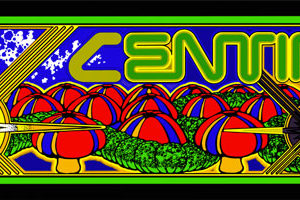 Centipede is a vertically oriented shoot ‘em up arcade game produced by Atari, Inc. in 1981. The game was designed by Ed Logg along with Dona Bailey, one of the few female game programmers in the industry at this time. It was also one of the first arcade coin-operated games to have a significant female player base, after Pac-Man. The player defends against centipedes, spiders, scorpions and fleas, completing a round after eliminating the centipede that winds down the playing field. The player is represented by a small, “somewhat humanoid head” at the bottom of the screen. The player moves the character about the bottom area of the screen with a trackball and fires laser shots at a centipede advancing from the top of the screen down through a field of mushrooms. Shooting any section of the centipede creates a mushroom; shooting one of the middle segments splits the centipede into two pieces at that point. Each piece then continues independently on its way down the board, with the first section of the rear piece becoming a new head. If the head is destroyed, the section behind it becomes the next head. The centipede starts at the top of the screen, traveling either left or right. When it hits a mushroom or the edge of the screen, it drops one level and switches direction. Thus, more mushrooms on the screen cause the centipede to descend more rapidly. The player can destroy mushrooms by shooting them, but each takes four hits to destroy. If the centipede reaches the bottom of the screen, it moves back and forth within the player area and one-segment “head” centipedes are periodically added. This continues until the player has eliminated both the original centipede and all heads. When all the centipede’s segments are destroyed, a new centipede forms at the top of the screen. Every time a centipede is eliminated, however, the next one is one segment shorter and is accompanied by one additional, fast-moving “head” centipede. A player loses a life when hit by a centipede or another enemy, such as a spider or a flea. The flea leaves mushrooms behind when fewer than five are in the player area, though the number required increases with level of difficulty. Spiders move across the player area in a zig-zag fashion and occasionally eat some of the mushrooms. Scorpions poison every mushroom they touch, but these never appear in the player’s movement region. A centipede touching a poisoned mushroom hurtles straight toward the player’s area. Upon reaching the player’s area, the centipede returns to normal behavior.
Centipede is a vertically oriented shoot ‘em up arcade game produced by Atari, Inc. in 1981. The game was designed by Ed Logg along with Dona Bailey, one of the few female game programmers in the industry at this time. It was also one of the first arcade coin-operated games to have a significant female player base, after Pac-Man. The player defends against centipedes, spiders, scorpions and fleas, completing a round after eliminating the centipede that winds down the playing field. The player is represented by a small, “somewhat humanoid head” at the bottom of the screen. The player moves the character about the bottom area of the screen with a trackball and fires laser shots at a centipede advancing from the top of the screen down through a field of mushrooms. Shooting any section of the centipede creates a mushroom; shooting one of the middle segments splits the centipede into two pieces at that point. Each piece then continues independently on its way down the board, with the first section of the rear piece becoming a new head. If the head is destroyed, the section behind it becomes the next head. The centipede starts at the top of the screen, traveling either left or right. When it hits a mushroom or the edge of the screen, it drops one level and switches direction. Thus, more mushrooms on the screen cause the centipede to descend more rapidly. The player can destroy mushrooms by shooting them, but each takes four hits to destroy. If the centipede reaches the bottom of the screen, it moves back and forth within the player area and one-segment “head” centipedes are periodically added. This continues until the player has eliminated both the original centipede and all heads. When all the centipede’s segments are destroyed, a new centipede forms at the top of the screen. Every time a centipede is eliminated, however, the next one is one segment shorter and is accompanied by one additional, fast-moving “head” centipede. A player loses a life when hit by a centipede or another enemy, such as a spider or a flea. The flea leaves mushrooms behind when fewer than five are in the player area, though the number required increases with level of difficulty. Spiders move across the player area in a zig-zag fashion and occasionally eat some of the mushrooms. Scorpions poison every mushroom they touch, but these never appear in the player’s movement region. A centipede touching a poisoned mushroom hurtles straight toward the player’s area. Upon reaching the player’s area, the centipede returns to normal behavior. -
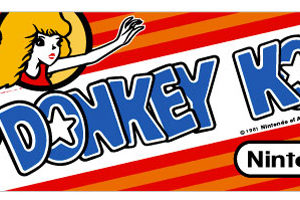 Donkey Kong is an arcade game released by Nintendo in 1981. It is an early example of the platform game genre, as the gameplay focuses on maneuvering the main character across a series of platforms while dodging and jumping over obstacles. In the game, Jumpman (since renamed Mario) must rescue a damsel in distress, Lady (now named Pauline), from a giant ape named Donkey Kong. The hero and ape later became two of Nintendo’s most popular characters. Donkey Kong is one of the earliest examples of the platform game genre; it is sometimes said to be the first platform game, although it was preceded by Space Panic. In contrast to Space Panic, however, Donkey Kong was the first platform game to feature jumping, introducing the need to jump between gaps and over obstacles or approaching enemies, setting the template for the platform genre. Competitive video gamers and referees stress the game’s high level of difficulty compared to other classic arcade games. Winning the game requires patience and the ability to accurately time Jumpman’s ascent. In addition to presenting the goal of saving the Lady, the game also gives the player a score. Points are awarded for finishing screens; leaping over obstacles; destroying objects with a hammer power-up; collecting items such as hats, parasols, and purses (apparently belonging to the Lady/Pauline); and completing other tasks. The player typically receives three lives with a bonus awarded for the first 7,000 points, although this can be modified via the game’s built in DIP switches. The game is divided into four different one-screen stages. Each represents 25 meters of the structure Donkey Kong has climbed, one stage being 25 meters higher than the previous. The final screen occurs at 100 m. Later ports of the game omit or change the sequence of the screens. The original arcade version includes: Screen 1 (25 m), Jumpman must scale a seven-story construction site made of crooked girders and ladders while jumping over or hammering barrels and oil barrels tossed by Donkey Kong. The hero must also avoid fireballs which generate when barrels run into the oil drum at the bottom of the site. Players routinely call this screen “Barrels”. Screen 2 (50 m), Jumpman must climb a five-story structure of conveyor belts, each of which transports cement pans. The fireballs also make another appearance. This screen is sometimes referred to as the “Factory” or “Pie Factory” due to the resemblance of the cement pans to pies. Screen 3 (75 m), Jumpman rides up and down elevators while avoiding fireballs and bouncing objects, presumably spring weights. The bouncing weights (the hero’s greatest danger in this screen) emerge on the top level and drop near the rightmost elevator. The screen’s common name is “Elevators”. This screen appears as an unlockable stage in Super Smash Bros. Brawl. Screen 4 (100 m), Jumpman must remove the eight rivets which support Donkey Kong. The fireballs remain the primary obstacle. Removing the final rivet causes Donkey Kong to fall and the hero to be reunited with Lady/Pauline. This is the final screen of each level. Players refer to this screen as “Rivets”. The player loses a life if: Jumpman collides with a barrel, fireball, flaming oil barrel, spring weight, cement pan, or Donkey Kong himself Jumpman falls off the structure or through open rivet holes The bonus timer reaches 0. These screens combine to form levels, which become progressively tougher. For example, Donkey Kong begins to hurl barrels faster and sometimes diagonally, and fireballs get speedier. The victory music alternates between levels 1 and 2. The 22nd level is unofficially known as the kill screen, due to an error in the game’s programming that kills Mario after a few seconds, effectively ending the game. With its four unique levels, Donkey Kong was the most complex arcade game at the time of its release, and only the second game to feature multiple levels (the first was Gorf by Midway Games).
Donkey Kong is an arcade game released by Nintendo in 1981. It is an early example of the platform game genre, as the gameplay focuses on maneuvering the main character across a series of platforms while dodging and jumping over obstacles. In the game, Jumpman (since renamed Mario) must rescue a damsel in distress, Lady (now named Pauline), from a giant ape named Donkey Kong. The hero and ape later became two of Nintendo’s most popular characters. Donkey Kong is one of the earliest examples of the platform game genre; it is sometimes said to be the first platform game, although it was preceded by Space Panic. In contrast to Space Panic, however, Donkey Kong was the first platform game to feature jumping, introducing the need to jump between gaps and over obstacles or approaching enemies, setting the template for the platform genre. Competitive video gamers and referees stress the game’s high level of difficulty compared to other classic arcade games. Winning the game requires patience and the ability to accurately time Jumpman’s ascent. In addition to presenting the goal of saving the Lady, the game also gives the player a score. Points are awarded for finishing screens; leaping over obstacles; destroying objects with a hammer power-up; collecting items such as hats, parasols, and purses (apparently belonging to the Lady/Pauline); and completing other tasks. The player typically receives three lives with a bonus awarded for the first 7,000 points, although this can be modified via the game’s built in DIP switches. The game is divided into four different one-screen stages. Each represents 25 meters of the structure Donkey Kong has climbed, one stage being 25 meters higher than the previous. The final screen occurs at 100 m. Later ports of the game omit or change the sequence of the screens. The original arcade version includes: Screen 1 (25 m), Jumpman must scale a seven-story construction site made of crooked girders and ladders while jumping over or hammering barrels and oil barrels tossed by Donkey Kong. The hero must also avoid fireballs which generate when barrels run into the oil drum at the bottom of the site. Players routinely call this screen “Barrels”. Screen 2 (50 m), Jumpman must climb a five-story structure of conveyor belts, each of which transports cement pans. The fireballs also make another appearance. This screen is sometimes referred to as the “Factory” or “Pie Factory” due to the resemblance of the cement pans to pies. Screen 3 (75 m), Jumpman rides up and down elevators while avoiding fireballs and bouncing objects, presumably spring weights. The bouncing weights (the hero’s greatest danger in this screen) emerge on the top level and drop near the rightmost elevator. The screen’s common name is “Elevators”. This screen appears as an unlockable stage in Super Smash Bros. Brawl. Screen 4 (100 m), Jumpman must remove the eight rivets which support Donkey Kong. The fireballs remain the primary obstacle. Removing the final rivet causes Donkey Kong to fall and the hero to be reunited with Lady/Pauline. This is the final screen of each level. Players refer to this screen as “Rivets”. The player loses a life if: Jumpman collides with a barrel, fireball, flaming oil barrel, spring weight, cement pan, or Donkey Kong himself Jumpman falls off the structure or through open rivet holes The bonus timer reaches 0. These screens combine to form levels, which become progressively tougher. For example, Donkey Kong begins to hurl barrels faster and sometimes diagonally, and fireballs get speedier. The victory music alternates between levels 1 and 2. The 22nd level is unofficially known as the kill screen, due to an error in the game’s programming that kills Mario after a few seconds, effectively ending the game. With its four unique levels, Donkey Kong was the most complex arcade game at the time of its release, and only the second game to feature multiple levels (the first was Gorf by Midway Games).